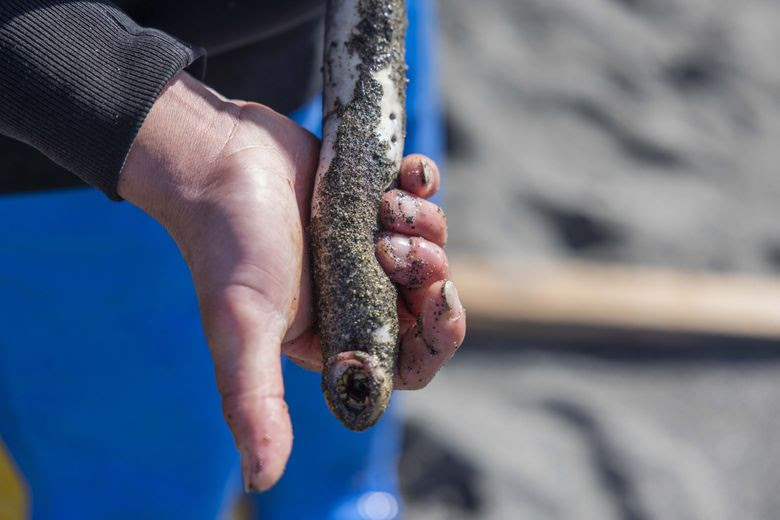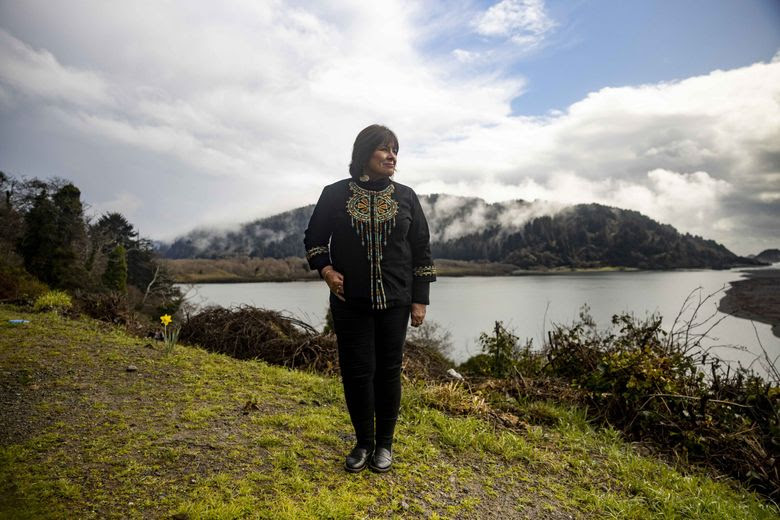~~ recommended by emil karpo ~~
MOUTH OF THE KLAMATH RIVER, California — Sheldon SmilingCoyote locked his eyes on the push and pull of the waves in front of him, suddenly slashing the tip of his handheld hook through the water, pulling out a slimy prehistoric fish.
Lassoing the lamprey over his head to keep it from squirming off the hook, he ran to a hole he’d dug in the sand and released the fish on a pile of its relatives. SmilingCoyote tallied two dozen in his catch on a late February day.
These nutrient-rich fish, a wintertime staple for the Yurok people, lost 400 miles of their historical spawning habitat to four dams that transformed the churning upper reaches of the Klamath River into slack water, threatening the lamprey and other native species. But that’s set to change.
This year, Yurok and Karuk tribal members began pressing the roots of native plants like Oregon ash and Klamath plum into the fluffy volcanic soil surrounding the Iron Gate Reservoir, some 200 miles east of the free-flowing water at the river’s mouth. It’s the first in a series of three pools that will be reverted to those lush flows when the dams are destroyed in what may be the nation’s largest planned dam removal project, already underway.
The Yurok and Karuk tribes have been connected to the Klamath River for thousands of years, but that relationship was disrupted by the construction of dams more than 100 years ago. Following the largest fish die-off in U.S. history, the tribes launched a decadeslong fight to remove the dams, a nearly complete effort that is poised to restore the lower Klamath River back to “the creator’s country.” Watch the short documentary below.
The Seattle Times traveled from the Klamath’s mouth, among the towering redwood forests of Northern California, through the ancestral lands of the Yurok, Karuk and Hupa, to the concrete dams set to come down and to the farmland and ranches the basin supports. The stories told along the way not only paint a picture of a decadeslong fight to restore a river’s flow and a way of life but also the distinct challenges of finding enough water to go around amid a changing climate. The dam’s removal won’t resolve a growing water crisis. Yet what happens on the Klamath has implications for dammed rivers across the American West.

The Indigenous people of the Klamath have worked from a blueprint drawn by the Northwest’s Lower Elwha Klallam Tribe, which successfully fought for the removal of two dams on the Elwha River of the Olympic Peninsula. They seek to heal the damage done over the last 150 years of colonization. Restoring balance in the river could mean the return of food sovereignty and a repaired relationship with the land for a Salmon People.
It could serve as an example for the Salmon People of the Columbia Basin, who have been fighting for a similar future for the Snake River that once teemed with Chinook. But one bigger barrier stands in their way — the support of Congress.
In the West, a region plagued by drought, it’s a massive undertaking to bring back rivers’ historical flows. These freshwater highways are being sucked dry to support government-subsidized farms, cattle ranches and everything that remade the identity of these places.
While Indigenous people were promised the right to continue their subsistence life in exchange for their vast homelands, the federal government also promised settlers water to begin a new tradition: draining and filling wetlands to plant foreign crops, taming the rivers and valleys.
Now, a political tug-of-war is playing out in an attempt to mend broken promises.


In the coastal town of Klamath, at the westernmost edge of the Yurok Reservation, there are no grocery stores. Instead, there’s a gas station minimart that smells of evergreen-tree-shaped car air fresheners. Behind refrigerator doors are few meal options — Hot Pockets, frozen burritos and some TV dinners.
Here, the lamprey are known as “salvation fish.” After adult salmon have spawned and died off in the fall, the Yurok people rely on the long, ugly fish for sustenance in the winter months. SmilingCoyote learned to hook them when he was 5 and started making his way to the mouth of the river on his own as a 12-year-old.
“It’s just as important as anything else that swims in the river,” SmilingCoyote said. “Everything is valuable here. Even if it’s not edible, it’s sustainable to the earth. If this river was to ever dry up and go away, we wouldn’t be the people that we are. The river is everything.”
A century of strife
The Yurok creation story, in short, says the creator made the land, the water, the creatures and last, the Yurok people. If the people took care of the land, water and creatures, and never took more than they needed, they would always have enough.
Susan Masten’s grandmother lived in a redwood plank house overlooking the mouth of the Klamath, its boards now in a pile on the family’s property. She gathered roots and berries, fish and mussels.
Before colonizers trampled the Klamath watershed during the gold rush, the Yurok people had lived in this same area for tens of thousands of years and upheld their end of the creation-story bargain. But for years, “the only people bearing the burden of conservation were the Indian people on the river,” said Masten, former chair of the Yurok Tribe.
It was here in 1969 that California game wardens arrested her uncle, Raymond Mattz, and confiscated his and his friends’ gillnets. So began the fishing wars.

In 1973, the U.S. Supreme Court recognized the rights of Yurok people to fish on the reservation. A few years later, the California Department of Fish and Wildlife closed tribal fishing on the Klamath under the auspices of conservation while the sport and commercial fisheries carried on.
Intense clashes between protesters and federal officials ensued. Law enforcement agents wore bulletproof vests and helmets, Masten recalled. They rammed Yurok boats and ripped up nets. One officer told Masten they were there to “protect the salmon.”
No comments:
Post a Comment